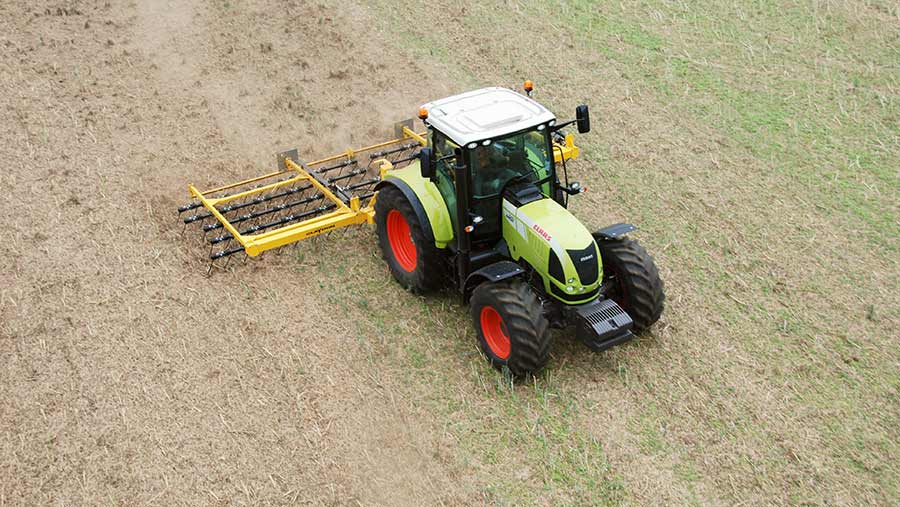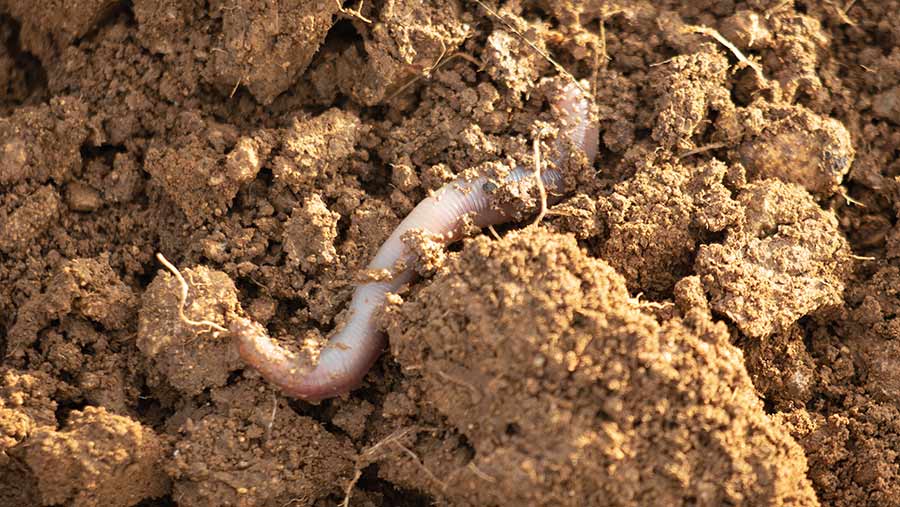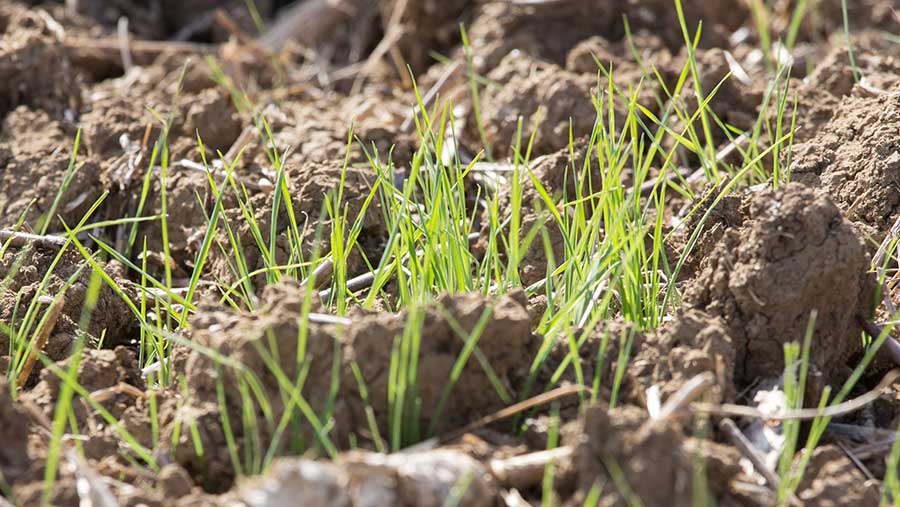The best way to manage stubbles after harvest

Unless you are one of a growing number of no-tillers or you plough every year, it is difficult to be prescriptive when it comes to post-harvest cultivation strategy.
There is residue management to consider, the potential requirement of remedial work on soil structure – and all while trying to get the perfect seed bed prepped for the following crop.
However, with many farms grappling with problem weeds, particularly grassweeds, correct identification and understanding of the biology of each species is vital in order to adapt stubble management strategy to each situation.
See also: How to plough to bury your blackgrass
That’s the view of Hutchinsons technical manager Dick Neale, who says growers are often too dogmatic in what they do once the combine has left the field, often to the detriment of weed control.
Post-harvest stubble management – key points
- Evidence suggests no significant reduction of most annual weeds by early stubble tillage in dry conditions, so consider leaving soil uncultivated to allow predation and germination of fresh seed.
- In damper conditions, cultivation after harvest can increase germination of freshly shed seeds where they are moved into moisture and older seeds exposed to light.
- Volunteer cereals can be cultivated immediately after harvest, particularly if moisture is present.
- Oilseed rape seed losses at harvest should be left on the soil surface for 4-6 weeks to avoid seeds becoming dormant.
- Always prioritise seed-bed quality over other factors to ensure rapid crop establishment and good pre-emergence herbicide efficacy.
Brome infestation
He gives one example of a farm he visited recently, which was experiencing high levels of meadow brome across 120ha of its winter barley area.
When cultivation strategy was discussed, it turned out that the farm always cultivates everything within 48 hours of a crop being cut, with no consideration of the potential agronomic consequences.
As many meadow brome seeds are thrown out of the back of the combine at an immature stage, it requires about one month’s exposure to sunlight and diurnal temperature fluctuations to finish maturation, break dormancy and germinate. It can then be sprayed off ahead of drilling.
As the grower was burying the meadow brome seed in a dormant state, it is likely that it retained that dormancy until it was brought back up to the surface, where it germinated in the crop.
“Some growers will continue doing the same thing because that’s the way it has always been done – and if you don’t have any grassweed problems, that’s fine, as you can pretty much do what you like,” says Mr Neale.
“But where there are grassweed problems, they need to be identified correctly and each species’ biology understood to get stubble management right.”
Surface depletion
There has been a trend towards earlier post-harvest cultivation over recent years, with the sole purpose of encouraging germination of freshly shed weed seeds, but there is little evidence to show this is the right approach in all situations.
In fact, a research review commissioned by the AHDB and carried out by Sarah Cook at Adas suggests that it might be far wiser to leave seeds of most weed species, including blackgrass, on the soil surface.
However, former Niab Tag agronomist and weed specialist Jim Orson believes the situation is more nuanced and for many (but not all) weed species it is a question of providing the best moisture conditions for seed germination.
So, where the soil is bone dry after harvest and there is no substantive rain forecast, seed on the soil surface (possibly under a straw cover) may experience more moisture from dews and any light showers than if the soil is lightly cultivated.
This means not cultivating at all provides better conditions for germination.
“On the other hand, where there are moist soil conditions directly after harvest, the seed will experience better conditions for germination after a shallow cultivation,” Mr Orson explains.
“It is not only common sense; for blackgrass, this conclusion is supported by field trials.”
However, he notes that some weeds must be retained on the soil surface in all weathers, including meadow, soft and rye brome, which should be left on the soil surface for a month.
In addition, wild oats should be left on the soil surface for as long as possible in the autumn.
Where high numbers of sterile or great brome seeds are on the soil surface, ploughing to a depth of 15-20cm will cause suicidal germination, while shallow surface cultivation will encourage a chit and the opportunity to spray off with glyphosate.
Good straw cover, where it is being chopped and spread, may also provide adequate darkness to trigger seedling growth.
Cereal volunteers – provided there is adequate soil moisture – should also be shallow-cultivated into the soil to encourage a flush.
Conversely, oilseed rape seeds should be left on the surface for four to six weeks, or growers will risk creating future problems.
Incorporating freshly shed oilseed rape seeds into the soil straight after harvest makes them dormant, resulting in greater volunteer emergence in future seasons.
Optimum establishment
It is clear that there is some conflicting advice in the area of post-harvest stubble management and the industry needs comprehensive, multi-year trials to identify the best approach in a range of situations.
However, independent grassweed expert Stephen Moss believes flexibility is the key, as conditions vary so much from field to field and from year to year.
He agrees that leaving the soil undisturbed for a period of time is best when soil conditions are dry, encouraging surface germination and depletion of weed seeds.
However, there is a better case for cultivating early when soil moisture is present, as this can trigger germination of freshly shed seed on the soil surface and help chit older seed, thus depleting the seed bank.
“Also, the notion of ‘as little tillage as possible’ to avoid encouraging blackgrass germination is sometimes oversold,” says Dr Moss.
“It’s certainly a valid concept, but not at the expense of the overriding priority, which should be seed-bed quality, both to maximise crop emergence and pre-emergence herbicide efficacy.
“Growers are increasingly dependent on residual herbicides for grassweed control, but getting the seed-bed right is something you have at least some control over.”
When and how to cultivate?
So, what is the practical advice on the best time to cultivate – and how to do it?
Clearly, much will depend on the crop being established, with oilseed rape and winter barley fitting into an earlier drilling window and leaving much less time for stale seed-bed preparation.
But leading into winter wheat, where delayed drilling is a key tactic in tackling grassweeds, Mr Neale sees little point in cultivating until mid-September, when the main blackgrass germination period kicks in. Other species such as ryegrass have similar germination periods.
When planning cultivations, he says, a minimum of two weeks should be allowed between cultivation passes and between cultivator and drill to allow a fresh weed flush for destruction.
For example, if aiming for a 15 October drill date, counting back two weeks will determine a final cultivation timing and a further two weeks back for the first pass.
Glyphosate can be applied ahead of the second cultivation, if necessary, with a final application going on ahead of the drill. Mr Neale also advises growers to work shallow when working in a relatively tight window.
“If you work to depth, you bring up raw, unweathered soil – and for that, you have to build in more weathering time. If you stay shallow – about 4-5cm – you don’t need the weathering to produce the final seed-bed,” he explains.
Cultivator set-up is also an important consideration, with the first pass needing to be well consolidated to achieve weed seed-to-soil contact – but not too fine, allowing the soil to maintain its aggregate stability.
“If you work the soil too fine too soon, even on the second pass, it will become sticky, unstable and prone to capping if it becomes wet and it just won’t dry out before drilling,” says Mr Neale.
“Using a very light movement with something like a stubble rake might be more appropriate to avoid overworking.”
Top tips on keeping soils in good condition

© Tim Scrivener
While grassweeds will be a big driver for many post-harvest stubble management strategies, there are five other factors to consider.
Independent soil and cultivations expert Philip Wright provides some top tips on keeping soils in good order for the following crop this summer and autumn.
1. Check crops now for areas of concern
Are there areas in the field that look compromised? If there are poor areas, investigate why and find out if it is a soil-related issue.
The best way to do that is to check crop roots. Dig a pit in a good area first to get a benchmark and follow up with soil pits in the bad areas and look for differences.
If soils are the same, it might mean soil analysis is required to investigate nutrient status, and other factors, including pH.
However, if roots are compromised by low soil porosity, you can start to think about cultivation strategy.
2. Residue management
When removing straw (whether you are doing it yourself or using a contractor), ensure that traffic and tyre pressures are adequately managed to avoid soil compaction.
If chopping straw on the combine, make sure it is making a consistent job.
This may mean more costly changing of chopper knives, but this is significantly cheaper than adding extra cultivation passes to manage lumpy residue and (sometimes) increased slug issues later on.
3. Default action should be less
Many factors drive the need for cultivation, but growers should avoid the mindset of doing what they have always done, at the same depth.
Instead, the default should be doing nothing at all, or doing it shallower, and increasing the depth and frequency of cultivation only if absolutely necessary to avoid overworking the soil and creating structural problems.
Rotating working depths season to season avoids creating “planes of weakness”, which can act as barriers to fine particles and create restrictions to water and root passage.
4. Consider drainage integrity
The pipes and outfalls are important, but consider if there is anything impeding water getting to the drainage system in the first place.
Where low porosity is identified and it is dry at depth, consider remedial work with a soil loosener, targeting only areas where action is required.
If soil is still plastic underneath, it is better to wait, or to working shallower if it is drier there, as more structural damage may occur. However, where mole ploughing is deployed, plasticity is ideal.
5. Avoid leaving land fallow
Especially for extended periods ahead of later-sown autumn or spring crops.
As soils near field capacity, if a growing cover crop can move out water, this creates wetting and drying cycles, which helps to create natural surface tilth.
Often, low seed rates are better as the soil surface remains open for such tilth formation and weed seed germination.
In turn, this helps to minimise the extent of further cultivations – a benefit to weed control and soil structure itself.
Glyphosate stewardship advice
Glyphosate plays a key role in managing weeds between harvest and drilling and growers are urged to stick to stewardship guidelines to avoid the evolution of resistance.
Its main use in the late summer and autumn is taking out annual grasses such as blackgrass, ryegrass, bromes and wild oats as growers look to deplete seedbanks before planting the next crop.
Regular use in this area has raised concerns about grassweeds developing resistance to the herbicide, which would make grassweed control more difficult and costly than it is now.
Barrie Hunt, Bayer’s glyphosate expert, says correct use will not only get the most out of the active but also minimise the risk of resistance developing.
Timing of application is important, and he cautions against applying too early. Growers can sometimes see large numbers of blackgrass seedlings – like “needles” – coming through and rush to spray.

© Tim Scrivener
Germination is often staggered because plants are emerging from slightly different depths.
This results in suboptimal control as the flush continues to come through post-application.
Mr Hunt urges patience and advises growers to wait until the targets are at the two- to three-leaf stage.
“Ideally, they should be sprayed before tillering with 540g/ha of glyphosate. If plants do start to tiller, increase the rate to 720g/ha to ensure a lethal dose is applied,” he adds.
Optimum application
With glyphosate often applied to stubbles or bare cultivated ground, complacency can creep in to spraying operations, but Mr Hunt says operators must approach this like any other treatment, such as an expensive pre-emergence herbicide stack.
That means reducing forward speed, maintaining optimum boom height and working with the right nozzles at the correct pressure to deliver a medium-coarse droplet, ideal for glyphosate and helping to minimise drift.
Low water volumes and the use of water conditioners where supplies are hard is also advised.
But perhaps the most important thing from a resistance management perspective is to avoid too many repeat applications to the same field.
According to Mr Hunt, as part of the AHDB glyphosate resistance management project, Adas gathered data from years of trials to find the optimum number of applications for weed control in any one autumn – and it was found to be just two.
“The difference between two and three sprays was about 2% [extra control], so there is definitely little benefit from more than that.
“For best results, we say use two 540g/ha applications spaced apart. Between applications, use a cultivation and consolidation to generate the next flush and act as a level of control, should there be any survivors,” he adds.
